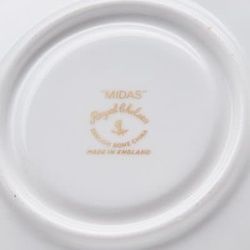
Основание фабрики -1745 г.
Ликвидация фабрики - 1784 г.
Самым древним из дошедших до наших дней изделием из английского мягкого фарфора является находящийся в Британском музее кувшинчик, датированный 1745 г. и имеющий клеймо фабрики в Челси (Лондон). Поэтому 1745 г. считают датой начала деятельности этой хронологически первой фарфоровой фабрики в Англии. Сначала ею управлял Шарль Гуэн, потом - Николя Спримон. Оба специалиста были выходцами из Бельгии. Спримон, при котором фабрика добилась больших успехов, после 1758 г. купил фабрику у Эверарда Фокенера. В 1769 г. хозяином на короткое время стал Джеймс Кокс, а год спустя фабрику приобрел Вильям Дуисбери, управляющий фабрикой в Дерби. Произошло объединение двух фабрик, и следствием этого явилась одинаковость продукции. После перенесения производства в Дерби фабрика в Челси в 1784 г. была окончательно закрыта.
Изделия первого периода (1745-1755) отличались молочно-белой глазурью, но она имела довольно много изъянов. Для украшения применялись разнообразные пластичные орнаменты, чаще всего в виде ракушек и жемчужин, а также цветочных рельефов. Палитра цвета вначале была весьма скромной: оттенки и позолота служили лишь акцентами на белом фоне глазури. Чувствовалось влияние Мейсена. Даже восточные мотивы брались не из китайских или японских образцов, а из мейсенских композиций.
Наибольший расцвет производства на фабрике Челси пришелся на годы 1756-1769 гг., когда ею управлял лично Спримон. Кроме столовой посуды выпускались цветные фигурки, представляющие отдельных лиц (сентиментальные псевдонародные пастушки, дворяне, богини) или групповые сцены (танцующие крестьяне, девушки на качелях). К этому периоду относится также сервиз, выполненный по заказу короля Георга III для герцога Мекленбургского. Он был украшен изображением экзотических птиц. В те годы в Челси были сделаны бюсты членов королевской семьи, смоделированные скульптором Луи Франсуа Рубильяком. Но более характерной для Челси была фарфоровая галантерея: флаконы для духов, табакерки, маленькие шкатулочки и бонбоньерки. Особенно славились флакончики для духов. Несмотря на миниатюрность размеров, они имели интересную, нигде не встречавшуюся форму. В вазочку укладывались маленькие фигурки, пустые внутри, в виде букетика цветов, декоративно уложенных фруктов, женской головы или играющих детей. Даже пробка представляла собой композицию, гармонирующую с темой флакона. Эти маленькие шедевры расписывали живыми, сочными красками. В период управления Спримона в Челси были введены новые, не применявшиеся до тех пор красители, и стала богаче позолота. Изделия походили по стилю на севрские, особенно покрытые темносиней эмалью бонбоньерки и шкатулочки. В то время с фабрикой сотрудничали два известных модельера с бельгийской фабрики в Турне: Джозеф Виллеме и Николя Франсуа Горон.
В 1770-1784 гг. фабрика находилась под влиянием фабрики в Дерби. Основным изделием этого периода являлись столовые сервизы, иногда с богатой позолотой. Излюбленным мотивом украшения были бабочки. Постепенно фабрика в Челси теряла свою индивидуальность, и продукция обеих фабрик стала почти одинаковой.








